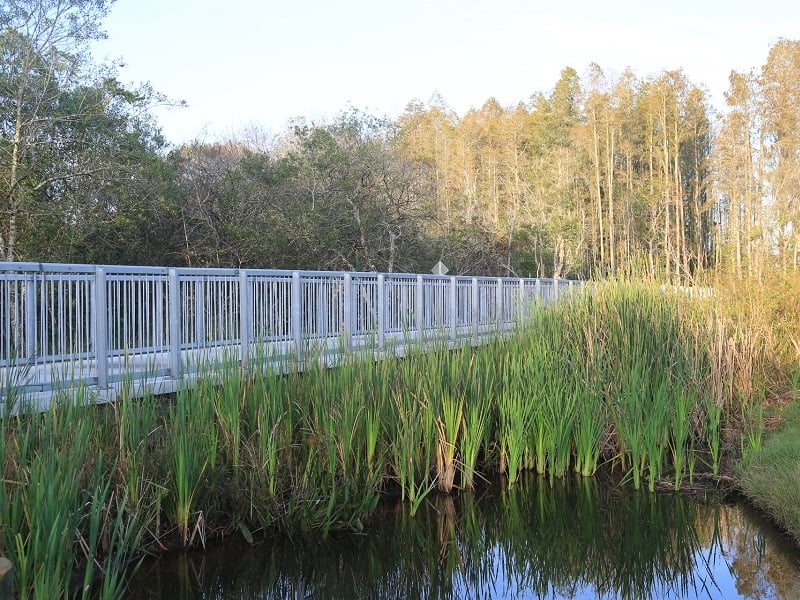Concerns for Designing a Boardwalk Over Wetlands
Landscape architects and engineers who are building boardwalks over wetlands often have several concerns, including:
- the environmental impact of the construction process
- the aesthetic appearance of the finished product
- the long-term impact of the boardwalk material to the surrounding wetlands
It’s vital to consider which materials to use in wetland boardwalks and the effect they will have on the ecosystem.
But what factors are most important for wetland-specific boardwalk construction? Wetlands contribute to unique ecosystems that require special considerations. The ultimate goal of a wetland boardwalk is to provide access into or through the wetland in a manner that will not degrade the ecosystem.
The three most common materials for commercial boardwalks are:
- Pressure-treated timber
- Wood-plastic composites
- Precast concrete
Pressure-Treated Timber vs. Composite Decking vs. Precast Concrete
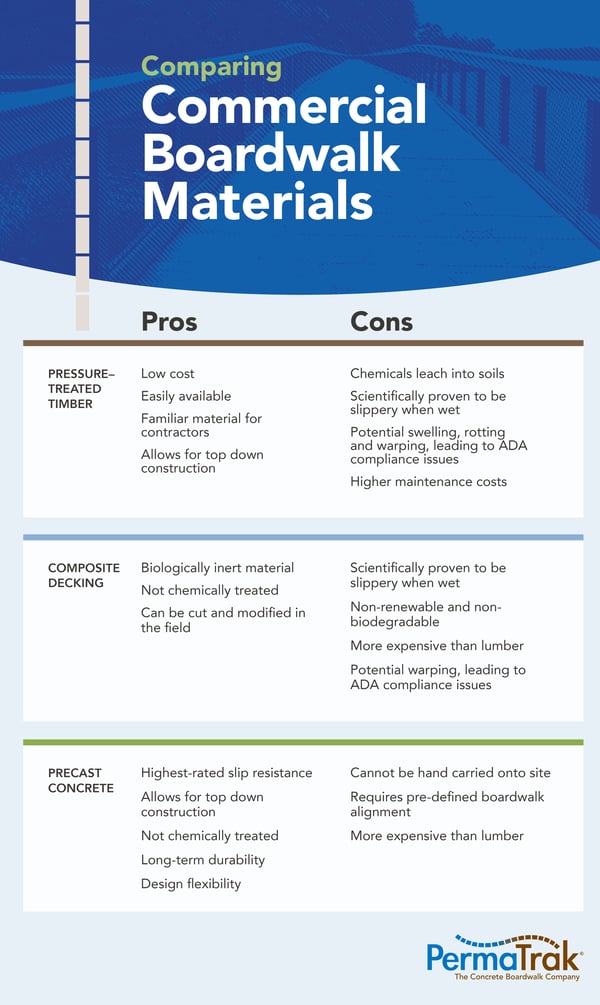
Pressure-Treated Timber
Pros. Wood is often considered a desirable building material because it’s a natural product, but two of the biggest benefits of using pressure-treated timber decking for a wetland boardwalk are the low cost and widespread availability of the material itself. General contractors can easily access pressure-treated decking through their suppliers, and the vast majority of contractors have already built timber boardwalks. Wood is a common building material and the learning curve for boardwalk contractors is virtually non-existent.
Cons. The major drawbacks to using timber materials in a wetland environment occur overtime. Timber must be pressure-treated to minimize decay and warping and maximize longevity when used for a boardwalk. This involves chemicals that will eventually leach out of the material, which can be concerning and potentially damaging to the ecosystem of a wetland area.
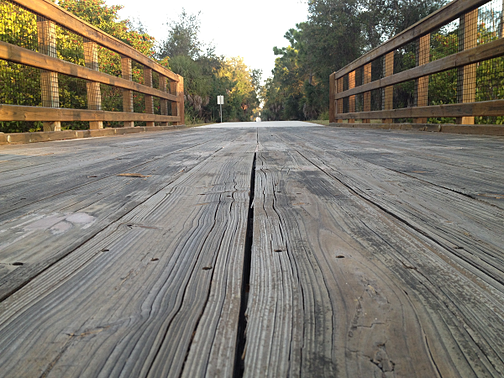
Even with treatment, there’s danger of swelling and rotting due to the moist nature of wetlands. Pressure-treated timber is also at risk for attracting the growth of algae and moss, which can be slippery and hazardous for pedestrians and runners. This is particularly common in wetlands. Removing this type of growth takes considerable time if done without chemicals, increasing the maintenance costs.
Composite Decking
Pros. Composites, which are most often a combination of plastic and wood fibers, are often presented as an ecologically-friendly alternative to timber. They are extremely popular for outdoor residential decking.
Perhaps the biggest benefit to using composite decking, instead of pressure-treated wood, on a wetland boardwalk is the fact that most composite decking products are biologically inert. This alleviates concerns of toxins or chemicals leaching into the soils over time. Composite decking is similar to wood in the sense that it can be cut and modified in the field as the boardwalk is being built. Contractors who have built timber boardwalks will usually be comfortable using the material.
Cons. A large drawback to using composite decking on a wetland boardwalk is the vulnerability to mold and algae, especially under heavy shade. Even with its plastic binders, most composite decking contains wood flour or sawdust as a filler material. This will absorb moisture once the outer, protective shell of the plank is permeated. Most composite decking products are not considered a “closed-cell material,” and moisture is likely to enter via the deck fasteners where screws or nails are used to tie into supporting beams.
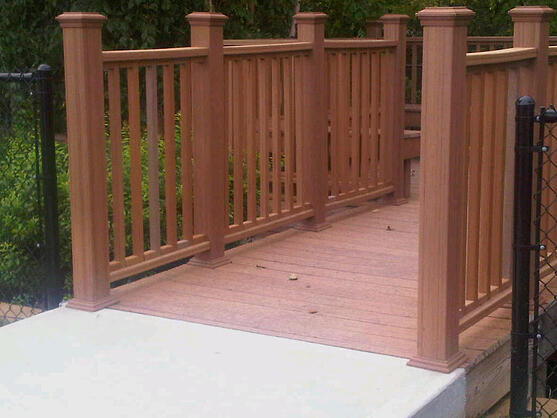
In addition, plastic decking is oil-based and can be very slippery, especially when it is wet. Finally, composite decking products are non-renewable, non-biodegradable and can be more expensive than timber.
Precast Concrete
Pros. A precast concrete boardwalk system is adaptable and customizable, because the individual components are produced specifically for your project. The design flexibility allows for approved construction equipment to drive over the top of the boardwalk during installation, diminishing harm to the ecosystem by not driving equipment or moving materials through the wetland for construction.
Precast concrete doesn’t contain chemical properties that would promote algae growth, increasing the durability and slip resistance of the boardwalk in a wetland environment. To further prevent hazards, precast concrete can be produced with slip-resistant textures.
Speaking long-term, the concrete material itself has an enormous advantage: No chemical sealants or stains are required to protect the surface from heavy use by pedestrians or cyclists, which leaves the wetland environment undisturbed for decades to come. Subsequently, maintenance costs are virtually non-existent compared to the other materials.
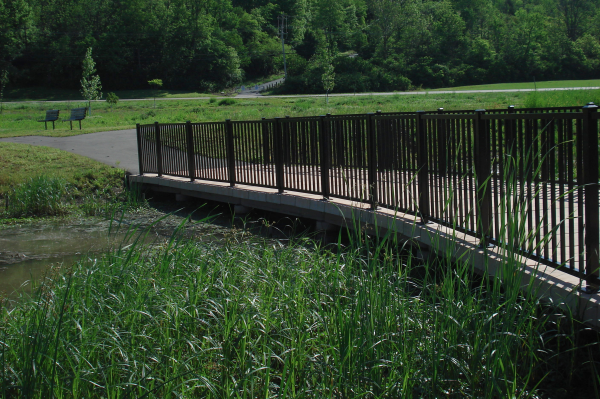
Cons. PermaTrak utilizes reinforced, precast concrete for wetland boardwalks. Depending on the boardwalk application, concrete may or may not be the best product for the site. If the boardwalk material must be hand carried to the boardwalk site, then concrete is probably not a good fit. The lightest concrete components weigh roughly 130 lbs. each and typically require light lifting equipment.
Boardwalks constructed through wetlands may require “open design” in the field, where the material must be cut and modified to adjust for obstructions or unforeseen curves. Concrete is not designed for saw-cutting and field adjustments to the components themselves. Most often, a designer will work with our engineering team on a predefined alignment to avoid this problem.
Depending on the project requirements, concrete will most likely be more expensive than timber. To calculate a concrete boardwalk budget estimate, see our article on boardwalk construction estimates.
Related Articles:
- How concrete can be an ecologically-friendly alternative to timber and composites.
- Boardwalk Construction Estimates: How Much Does a Concrete Boardwalk Cost?
- Boardwalks Through Wetland, Marsh or Mangrove: Installation Impact

